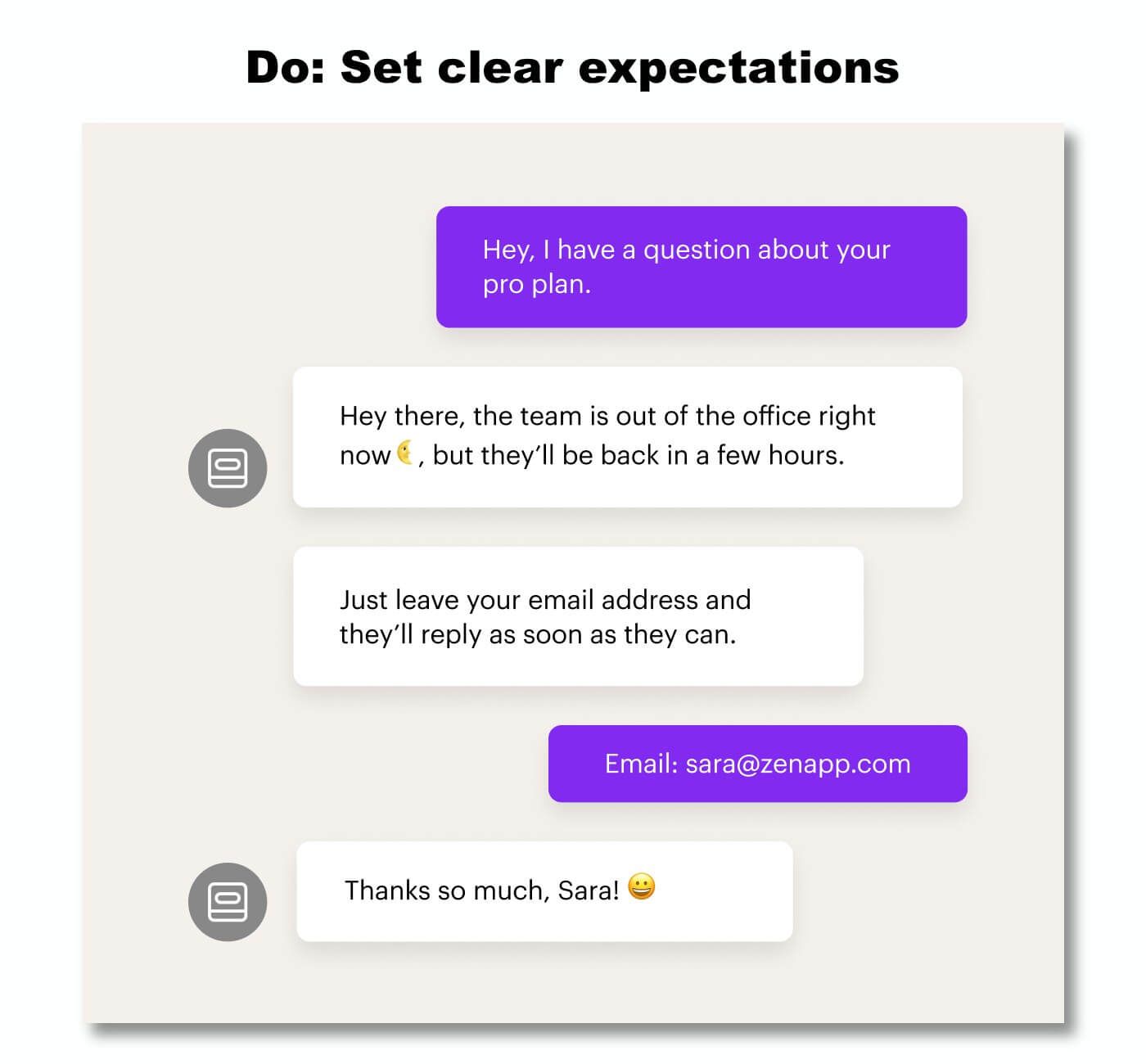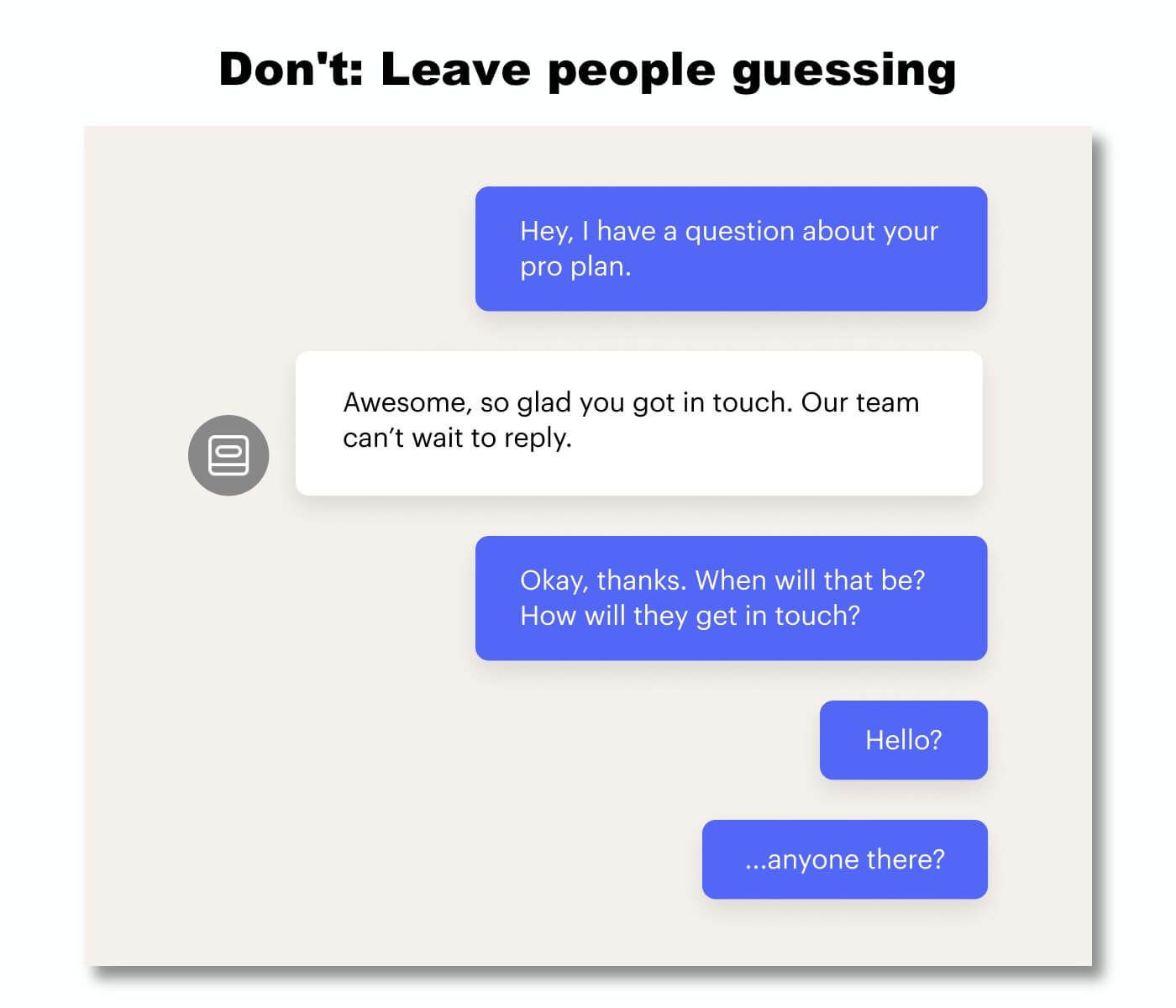
Proper botiquette – five rules for designing impactful chatbots
Main illustration: Aysha Tengiz
More and more companies are reaching the tipping point where their human teams can’t keep up with their growing volume of support conversations.
Chatbots are supposed to be the fix – providing basic help to customers while taking pressure off the team behind the scenes.
But there’s some tension at play. We need these chatbot interactions to be frequent enough to make a real impact on team capacity but thoughtful enough that they protect our hard-won customer relationships. There’s a lot riding on what our bots say – and how they say it.
Of course, there’s no one right way to design a chatbot. You’ll need to carefully tailor your chatbot’s voice, tone and its various paths to satisfy both your business and customer needs. That said, there are a few rules that will help you get more value from your bots and deliver better experiences for your customers. Below, we’ll share our five rules for chatbot etiquette (or “botiquette” for short 😉).
Rule 1: Not every interaction will benefit from a bot
Some time ago, when chatbots were new and we were still forming our opinion on them, our SVP of Product Paul Adams wrote a blog post discussing their limitations. In it, he argues that bots and humans are good at different things. While bots can quickly and safely resolve certain low-level repetitive tasks, he says, “they are not good for every low-level, repetitive question or task.”
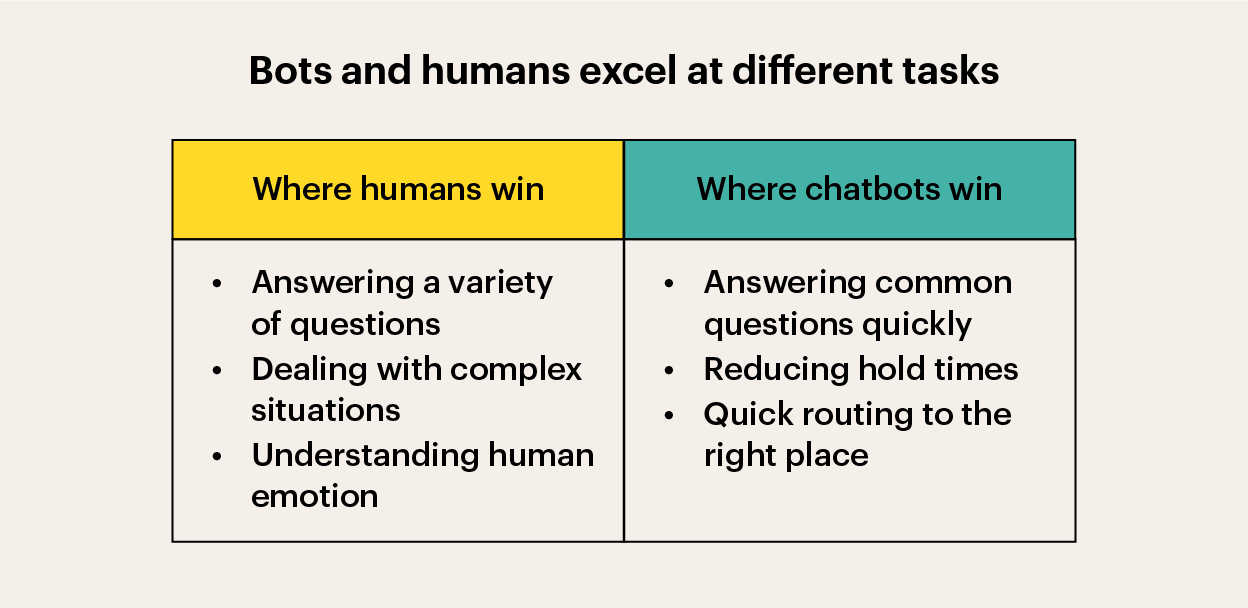
These days, we have LOTS of opinions on bots, but Paul’s point is just as true now as it was then – bots aren’t going to be good at everything. Building successful chatbots starts with choosing the right tasks to automate.
“How do you make an automated interaction, one that’s going to play out the same way for hundreds or thousands of people, still feel personal?”
The key to this is to focus on specific outcomes. A lot of companies set out to build chatbots that will automate their support conversations – but “automate conversations” on its own doesn’t mean anything. It’s too vague. Too broad. You need to dive a lot deeper into the details and answer questions like:
- What types of customer conversations occur most often?
- Which of those conversations are the most predictable (i.e. they only ever result in the same two to three outcomes)?
- Which have the lowest stakes, so that when the bot isn’t perfect it’s not going to upset your customers?
Building chatbots to automate these common, predictable, low-stakes interactions will dramatically increase their effectiveness.
Rule 2: Empathy is about anticipating needs, not saying nice things
Intercom’s mission is to make internet business personal. But how do you make an automated interaction, one that’s going to play out the same way for hundreds or thousands of people, still feel personal? We believe pretty strongly that automated interactions can still be empathetic interactions – but empathy isn’t always what you think.
The best customer support experience I’ve ever had was with (surprise, surprise) Apple. My aging MacBook had a battery that had just been recalled. I got an email from Apple alerting me about the recall and telling me what to expect next. The next day a foam-lined box arrived at my door that was the perfect size for my laptop. There was a sheet of paper inside with simple instructions for packing the box and arranging a pickup, and it promised my laptop would be back within 48 hours. The courier showed up promptly and whisked my computer away. 36 hours later another courier was knocking on my door to return it, fresh battery installed, charged up, and ready to go.
“The experience was empathetic because all of my needs were anticipated and addressed while I barely had to lift a finger”
I have never felt so looked after by any technical support experience before or since, and at no point did I interact with an Apple employee. What made this experience empathetic and personal had nothing to do with tone or pleasantries or politeness – any of the things humans would usually use to express empathy. The experience was empathetic because all of my needs were anticipated and addressed while I barely had to lift a finger.
The same holds true for chatbot interactions. Writing an empathetic chatbot has nothing to do with making the bot say nice things. It has everything to do with understanding your customers’ context and creating bots that accurately anticipate and address their needs.
Rule 3: Be careful with self-awareness
When designing chatbots there’s often a strong temptation to name your chatbot and give it a face, even a little personality of their own.
“When your chatbot uses language that suggests self awareness, there’s a high risk that your customers will assume it’s smarter than it is”
Depending on your brand and the kind of scenarios your chatbot is going to be working in, a little personality isn’t always a bad thing. But it can be risky.
When your chatbot uses language that suggests self awareness there’s a high risk that your customers will assume it’s smarter than it is. Things like names, introductions, and first-person pronouns all suggest to the customer that there’s a brain behind these interactions. If your bot introduces itself as a capable assistant and its capabilities don’t measure up, you’ll end up with some really frustrating interactions.
What it comes down to is making deliberate choices about how your bot talks about itself. Before you begin designing your bot, ask yourself (and your team) questions like:
- Does your bot use first person pronouns? Having a bot say “I” is one of the strongest indicators of self awareness, and carries the highest risk of overpromising the bot’s intelligence.
- Does the bot introduce itself or does it just jump straight in? If you’re explicit about when the bot enters a conversation, it’s important to be explicit later on, when it leaves too.
- Does your bot say “we” or “they” when talking about the team? This choice will help frame the bot either as a fully fledged robot support agent or as a separate, supplementary entity with a limited set of skills.
Make sure you have answers to all these questions before you sit down to write your bot’s interactions. The more confident you are that the bot can take care of your customers’ needs, the safer it is to give it a personality and some self awareness. But if you know your bot is only going to deliver a good experience for a subset of the people who interact with it, consider dialing back its personality.
Rule 4: Give people a choice
I talked earlier about there being a healthy tension in chatbot design between making sure the bot is as helpful for your customers as it is for your team. It’s a delicate balancing act: over-optimize for your customers and your team might not see enough benefit from the bots, but over-optimize for your team and you risk delivering bot experiences that damage your customer relationships.
“If your customer has engaged with a bot, and it’s not going well for them, there should be an easy way out”
One of the keys to getting that balance right is letting your customers choose whether to interact with your bot or not. If your customer has engaged with a bot, and it’s not going well for them, there should be an easy way out. Sometimes that means letting them through to your team. Other times it might just mean giving them clear next steps to your help center, forum, email support, etc.
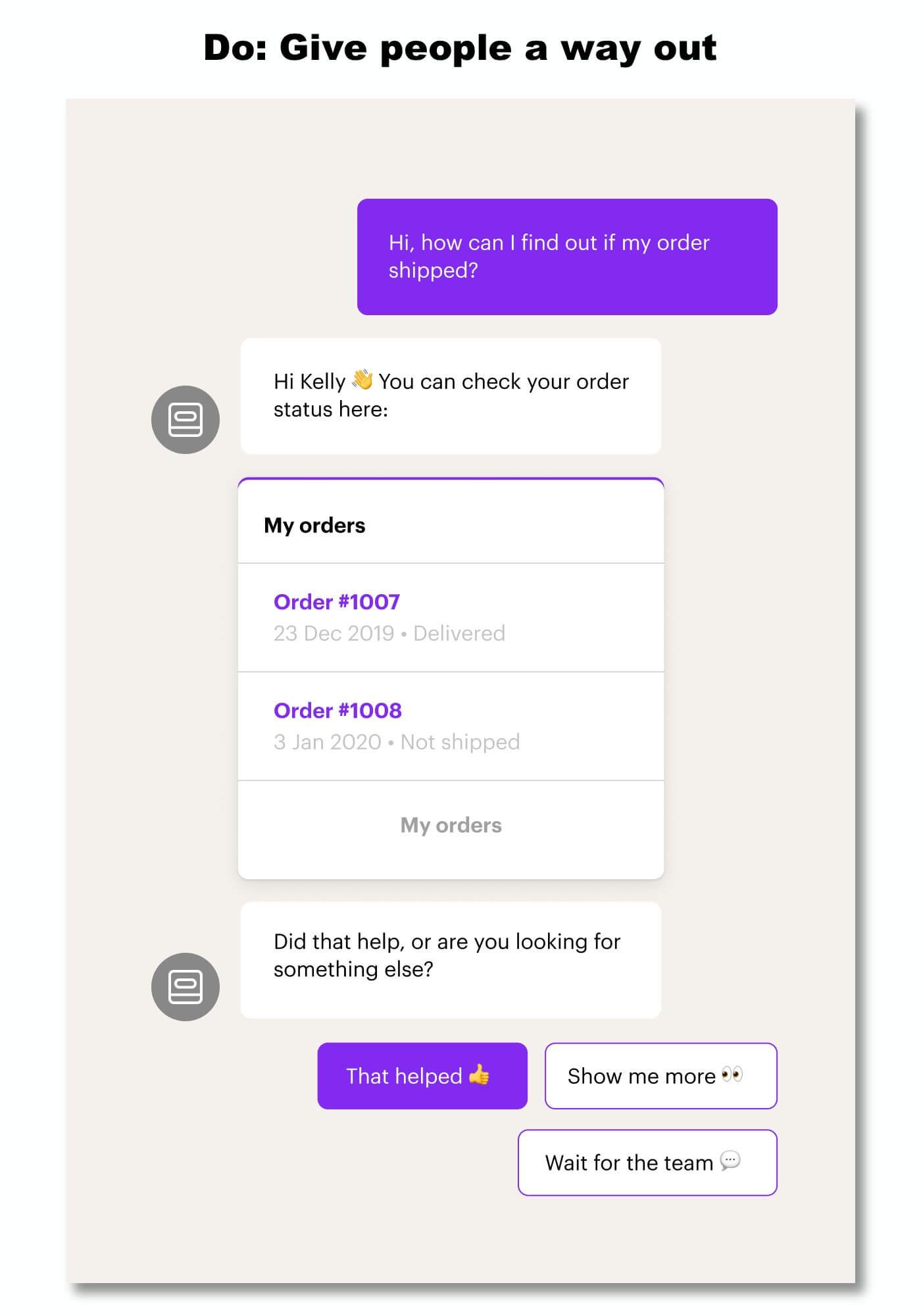
What you don’t want is to make them feel like they’re trapped in the chatbot equivalent of a phone tree. “Press 9 to hear these options again” is a far worse experience than letting them disengage from the bot entirely and providing clear next steps for how to find help.
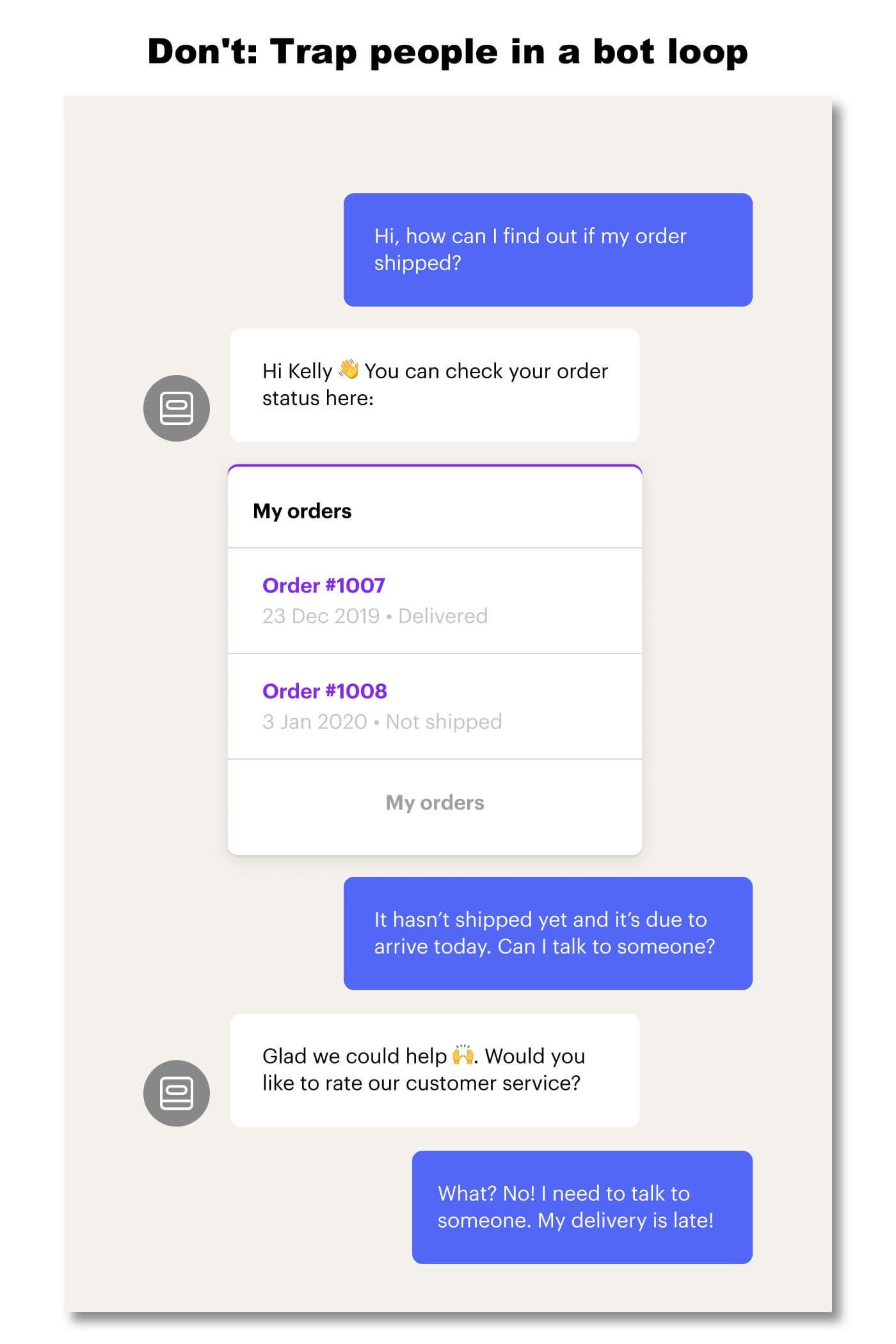
Rule 5: Write like you’d text (your boss)
The last thing to keep in mind when writing your bots is that messengers, as a medium, have specific conventions. Think about that one friend whose texts are giant, fully punctuated paragraphs (real talk – that friend is me 😅). It’s awkward! It feels clunky and unnatural because messengers are designed for quick, short messages sent back and forth. Keep things short and conversational, but not overly familiar. In other words, write your bot messages as if they’re texts to your boss.
The other thing to consider is emoji. They might not be right for every business or every industry, but if you’re on the fence on whether they’re worth using or not, consider this: when we looked at our customers’ emoji use and compared engagement rates between messages that included emoji and those that didn’t, we found that emoji increased the likelihood of engagement by 4x!
Botiquette starts with asking the right questions
Designing an effective chatbot starts with asking the right questions about what your bot can (and should) do for your customers. Get together with your team and ask questions like:
- What customer needs should your bot anticipate?
- How will it talk about itself?
- How can customers opt out?
- What tone is it going to strike?
Once you’ve answered these questions, you’ve already done half the work of designing an effective chatbot.

